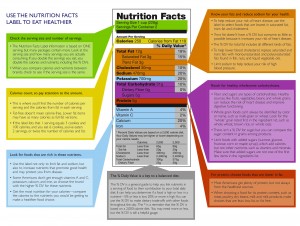Can You Read? A nutrition label
 Want to be healthy? Read it before you eat it! That is my motto. Properly reading a nutrition label is a MUST if you are considering making health part of your lifestyle. Many people do not know how to read a nutrition label because they have never been taught. Reading a nutrition label can be very easy and can make or break your diet. Always look at labels before buying foods at grocery stores. It is also not a bad idea to check out the nutrition facts online of your favorite restaurant. It is smart to know what you are putting into your body.
Want to be healthy? Read it before you eat it! That is my motto. Properly reading a nutrition label is a MUST if you are considering making health part of your lifestyle. Many people do not know how to read a nutrition label because they have never been taught. Reading a nutrition label can be very easy and can make or break your diet. Always look at labels before buying foods at grocery stores. It is also not a bad idea to check out the nutrition facts online of your favorite restaurant. It is smart to know what you are putting into your body.
This diagram can help you learn how to read a label (click on the picture for a bigger view):

Here’s how to get started on reading a nutrition label:
- Serving Size and servings per container: this describes the serving size in a common household measure (cups, Tbsp, tsp, etc…..the normal things you have around your house), a metric measure (grams) and how many servings are in the package. Serving size is VERY important. Most people do not just eat one serving of something unless they actually measure it or count it out. This may seem silly and obsessive, BUT count out the amount of chips you eat if it says serving size 15 chips. Or weigh your chicken if you are supposed to eat 4 oz. Be aware of the amount of calories you consume.
- Calories and calories from fat per serving: this describes the total number of calories and the total amount of calories from fat per one serving of that particular food. By looking at this part of the label, you can tell if your item is high in fat. If you divide your calories from fat into your calories and multiply by 100, you come up with a percentage number. If this percent is under 30%, it is relatively low in fat.
- List of nutrients: this describes the nutrient found in this item. The top items like total fat, saturated fat, cholesterol, sodium are generally items that we try to limit and become more healthy-conscious of. The items like fiber, Vitamin A, Vitamin C, and Iron are nutrients that we often don’t get enough of and need to strive to eat more.
- Percent Daily Values (%DV): this tells you how much a serving of food contributes to your overall intake of nutrients listed on the label. BUT because we are ALL different and have different nutritional needs, the FDA uses a standard based on a 2,000 calorie diet when referring to the %DV.
A few tips when looking at the back of food labels under the ingredients:
- Avoid foods that contain Trans Fat
- Limit your Saturated fat intake to 15g or less per day
- Pay attention to the amount of sugar your serving size has in it
- Choose high fiber items (3g or more per serving)
- Stay away from carbs (breads) that have enriched flour as the first ingredient
- Know how many calories you eat in a day
- Measure, count, measure, count! Know what a serving size looks like
** I am not an RD (Registered Dietitian) but I wanted to give you some basic information on how to read a nutrition label.

